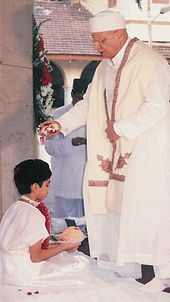
Back Sədrəpüşi Azerbaijani Navjote German Sedrepuşi DIQ سدرهپوشی Persian Navjote Italian ナオジョテ Japanese Навджот Russian Navjote Swedish Навджот Tatar
This article has multiple issues. Please help improve it or discuss these issues on the talk page. (Learn how and when to remove these messages)
|
| Part of a series on |
| Zoroastrianism |
|---|
 |
|
|

The Navjote (Persian: سدرهپوشی, sedreh-pushi) ceremony is the ritual through which an individual is inducted into the Zoroastrian religion and begins to wear the sedreh and kushti. The term navjote is used primarily by the Zoroastrians of India (the Parsis), while sedreh pushi is used primarily by the Zoroastrians of Iran.
The word 'navjote' is a Latinized form of the Parsi Gujarati compound of nav "new" and jote "reciter [of prayer]", "invoker", "sacrificer". The second half of the word is—via Zoroastrian Middle Persian zot—an indirect continuation of Avestan zaotar, with /z/ eventually becoming /j/ because /z/ is not phonemic in Gujarati. The Persian term sedreh pushi translates to "Putting on the sedreh," a reference to the main component of the ritual.